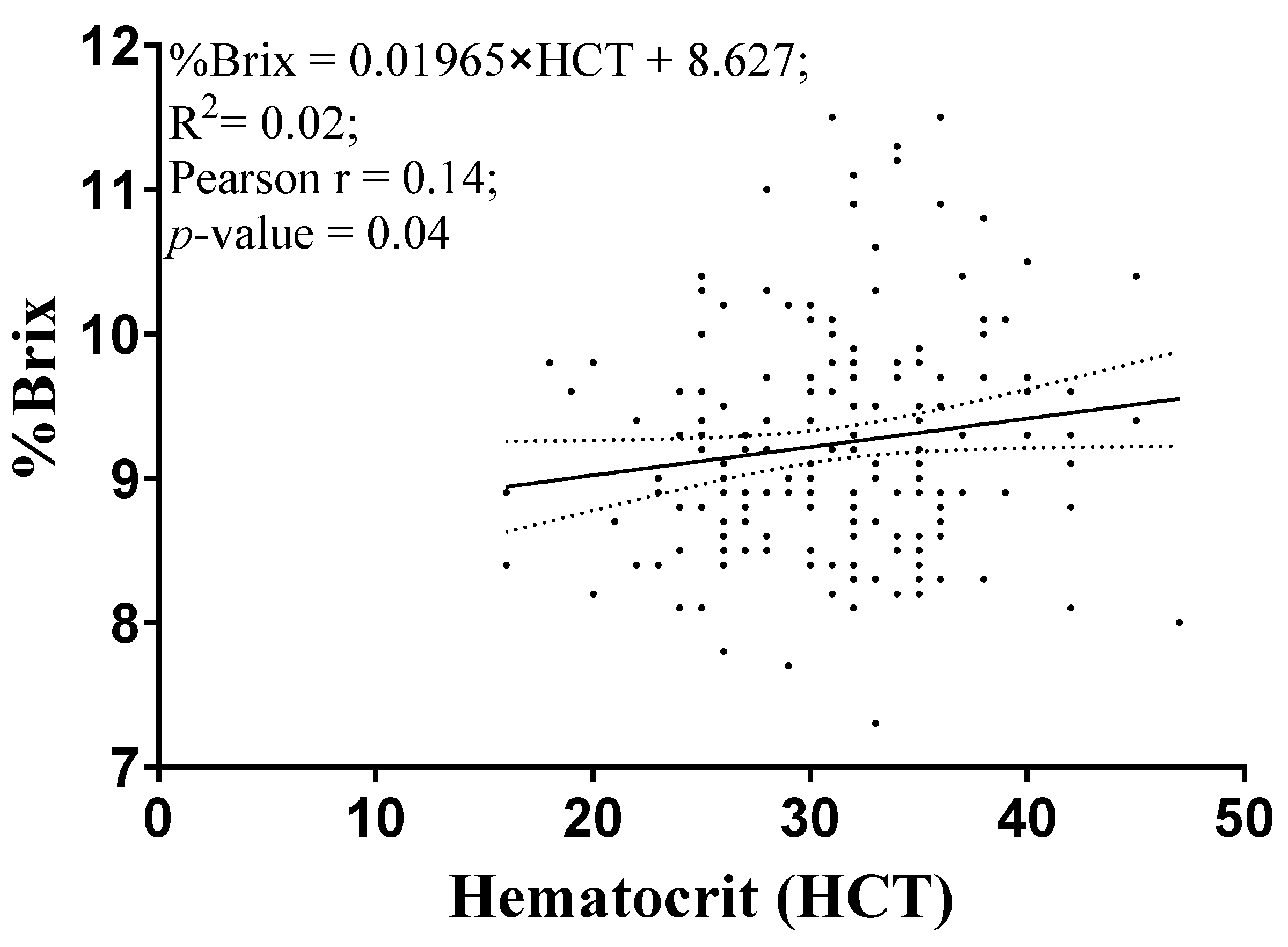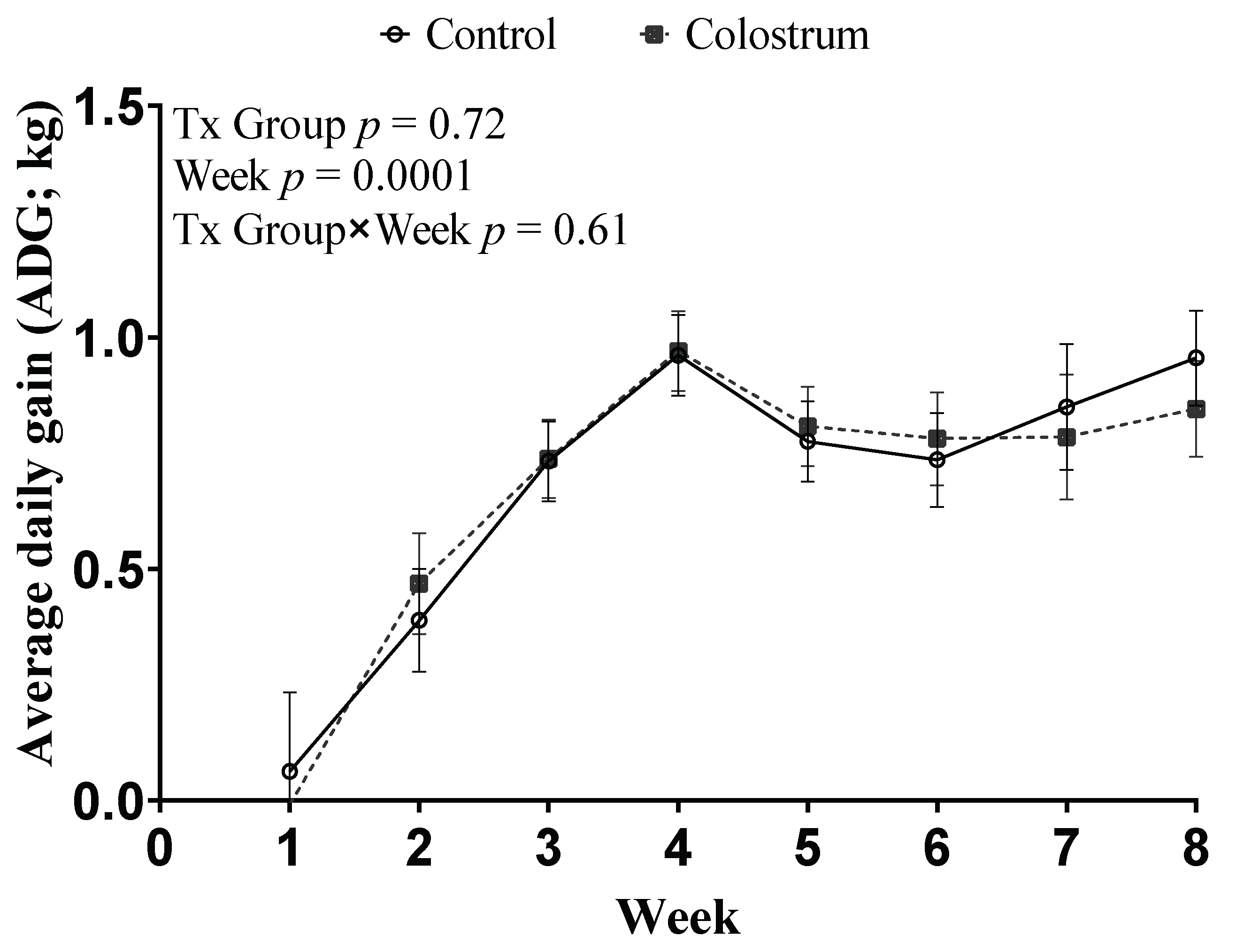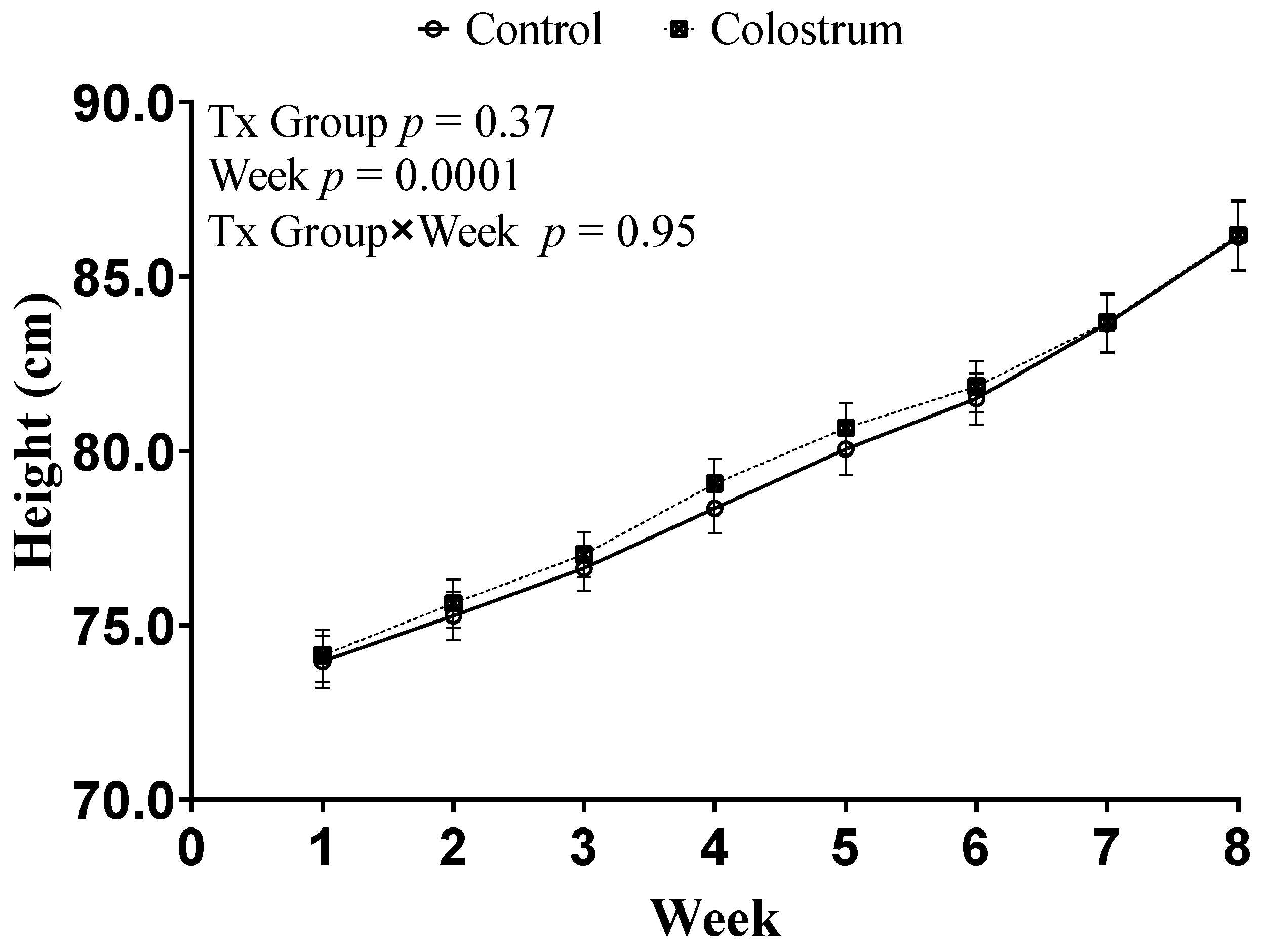Effects of Receiving Two Initial Feedings of Colostrum on the Average Daily Gain and Health of Pre-Weaning Group Housed Holstein Heifer Calves
Abstract
:Simple Summary
Abstract
1. Introduction
2. Materials and Methods
2.1. Data and Sample Collection
2.2. Statistical Analysis
3. Results
3.1. Description of Study Population and Treatment
3.2. Average Daily Gain and Height
3.3. Health Status
4. Discussion
5. Conclusions
Author Contributions
Funding
Institutional Review Board Statement
Acknowledgments
Conflicts of Interest
References
- Larson, B.L.; Heary, H.L.; Devery, J.E. Immunoglobulin Production and Transport by the Mammary Gland. J. Dairy Sci. 1980, 63, 665–671. [Google Scholar] [CrossRef]
- Foley, J.A.; Otterby, D.E. Availability, Storage, Treatment, Composition, and Feeding Value of Surplus Colostrum: A Review. J. Dairy Sci. 1978, 61, 1033–1060. [Google Scholar] [CrossRef]
- Blum, J.W.; Hammon, H.M. Bovine colostrum: More than just an immunoglobulin supplier. Schweiz. Arch. Tierheilkd. 2000, 142, 221–228. [Google Scholar]
- Mann, S.; Curone, G.; Chandler, T.L.; Moroni, P.; Cha, J.; Bhawal, R.; Zhang, S. Heat treatment of bovine colostrum: I. Effects on bacterial and somatic cell counts, immunoglobulin, insulin, and IGF-I concentrations, as well as the colostrum proteome. J. Dairy Sci. 2020, 103, 9368–9383. [Google Scholar] [CrossRef]
- Baumrucker, C.R.; Hadsell, D.L.; Blum, J.W. Effects of dietary insulin-like growth factor I on growth and insulin-like growth factor receptors in neonatal calf intestine1. J. Anim. Sci. 1994, 72, 428–433. [Google Scholar] [CrossRef]
- Playford, R.J.; Weiser, M.J. Bovine Colostrum: Its Constituents and Uses. Nutrients 2021, 13, 265. [Google Scholar] [CrossRef] [PubMed]
- Roffler, B.; Fäh, A.; Sauter, S.N.; Hammon, H.M.; Gallmann, P.; Brem, G.; Blum, J. Intestinal Morphology, Epithelial Cell Proliferation, and Absorptive Capacity in Neonatal Calves Fed Milk-Born Insulin-Like Growth Factor-I or a Colostrum Extract. J. Dairy Sci. 2003, 86, 1797–1806. [Google Scholar] [CrossRef]
- Mann, S.; Curone, G.; Chandler, T.L.; Sipka, A.; Cha, J.; Bhawal, R.; Zhang, S. Heat treatment of bovine colostrum: II. Effects on calf serum immunoglobulin, insulin, and IGF-I concentrations, and the serum proteome. J. Dairy Sci. 2020, 103, 9384–9406. [Google Scholar] [CrossRef]
- Fischer, A.; Song, Y.; He, Z.; Haines, D.; Guan, L.; Steele, M. Effect of delaying colostrum feeding on passive transfer and intestinal bacterial colonization in neonatal male Holstein calves. J. Dairy Sci. 2018, 101, 3099–3109. [Google Scholar] [CrossRef] [Green Version]
- Hammon, H.M.; Blum, J.W. Metabolic and Endocrine Traits of Neonatal Calves Are Influenced by Feeding Colostrum for Different Durations or Only Milk Replacer. J. Nutr. 1998, 128, 624–632. [Google Scholar] [CrossRef]
- Hammon, H.M.; Zanker, I.A.; Blum, J.W. Delayed Colostrum Feeding Affects IGF-I and Insulin Plasma Concentrations in Neonatal Calves. J. Dairy Sci. 2000, 83, 85–92. [Google Scholar] [CrossRef]
- Hammon, H.M.; Steinhoff-Wagner, J.; Flor, J.; Schönhusen, U.; Metges, C.C. Lactation biology symposium: Role of colostrum and colostrum components on glucose metabolism in neonatal calves 1,2. J. Anim. Sci. 2013, 91, 685–695. [Google Scholar] [CrossRef] [Green Version]
- Ontsouka, E.C.; Albrecht, C.; Bruckmaier, R.M. Invited review: Growth-promoting effects of colostrum in calves based on interaction with intestinal cell surface receptors and receptor-like transporters. J. Dairy Sci. 2016, 99, 4111–4123. [Google Scholar] [CrossRef]
- Pyo, J.; Hare, K.; Pletts, S.; Inabu, Y.; Haines, D.; Sugino, T.; Guan, L.; Steele, M. Feeding colostrum or a 1:1 colostrum:milk mixture for 3 days postnatal increases small intestinal development and minimally influences plasma glucagon-like peptide-2 and serum insulin-like growth factor-1 concentrations in Holstein bull calves. J. Dairy Sci. 2020, 103, 4236–4251. [Google Scholar] [CrossRef]
- Godden, S.M.; Lombard, J.E.; Woolums, A.R. Colostrum Management for Dairy Calves. Veter. Clin. N. Am. Food Anim. Pr. 2019, 35, 535–556. [Google Scholar] [CrossRef]
- Abuelo, A.; Cullens, F.; Hanes, A.; Brester, J.L. Impact of 2 Versus 1 Colostrum Meals on Failure of Transfer of Passive Immunity, Pre-Weaning Morbidity and Mortality, and Performance of Dairy Calves in a Large Dairy Herd. Animals 2021, 11, 782. [Google Scholar] [CrossRef]
- USDA APHIS|NAHMS Dairy Studies. Available online: https://www.aphis.usda.gov/aphis/ourfocus/animalhealth/monitoring-and-surveillance/nahms/NAHMS_Dairy_Studies (accessed on 31 May 2021).
- Virtala, A.-M.K.; Mechor, G.D.; Gröhn, Y.T.; Erb, H.N. The Effect of Calfhood Diseases on Growth of Female Dairy Calves During the First 3 Months of Life in New York State. J. Dairy Sci. 1996, 79, 1040–1049. [Google Scholar] [CrossRef]
- Shamay, A.; Werner, D.; Moallem, U.; Barash, H.; Bruckental, I. Effect of Nursing Management and Skeletal Size at Weaning on Puberty, Skeletal Growth Rate, and Milk Production During First Lactation of Dairy Heifers. J. Dairy Sci. 2005, 88, 1460–1469. [Google Scholar] [CrossRef]
- Soberon, F.; Raffrenato, E.; Everett, R.W.; Van Amburgh, M.E. Preweaning milk replacer intake and effects on long-term productivity of dairy calves. J. Dairy Sci. 2012, 95, 783–793. [Google Scholar] [CrossRef] [Green Version]
- Weaver, D.M.; Tyler, J.W.; VanMetre, D.C.; Hostetler, D.E.; Barrington, G.M. Passive Transfer of Colostral Immunoglobulins in Calves. J. Veter. Intern. Med. 2000, 14, 569–577. [Google Scholar] [CrossRef]
- McGrath, B.A.; Fox, P.F.; McSweeney, P.L.H.; Kelly, A.L. Composition and properties of bovine colostrum: A review. Dairy Sci. Technol. 2016, 96, 133–158. [Google Scholar] [CrossRef]
- Elsohaby, I.; McClure, J.T.; Keefe, G.P. Evaluation of Digital and Optical Refractometers for Assessing Failure of Transfer of Passive Immunity in Dairy Calves. J. Veter. Intern. Med. 2015, 29, 721–726. [Google Scholar] [CrossRef]
- Lombard, J.; Urie, N.J.; Garry, F.; Godden, S.; Quigley, J.D.; Earleywine, T.; McGuirk, S.; Moore, D.; Branan, M.; Chamorro, M.; et al. Consensus recommendations on calf- and herd-level passive immunity in dairy calves in the United States. J. Dairy Sci. 2020, 103, 7611–7624. [Google Scholar] [CrossRef]
- Deelen, S.M.; Ollivett, T.L.; Haines, D.M.; Leslie, K.E. Evaluation of a Brix refractometer to estimate serum immunoglobulin G concentration in neonatal dairy calves. J. Dairy Sci. 2014, 97, 3838–3844. [Google Scholar] [CrossRef]
- Shivley, C.B.; Lombard, J.E.; Urie, N.J.; Kopral, C.A.; Santin, M.; Earleywine, T.; Olson, J.; Garry, F. Preweaned heifer management on US dairy operations: Part VI. Factors associated with average daily gain in preweaned dairy heifer calves. J. Dairy Sci. 2018, 101, 9245–9258. [Google Scholar] [CrossRef] [Green Version]
- Hammon, H.; Blum, J.W. Prolonged colostrum feeding enhances xylose absorption in neonatal calves. J. Anim. Sci. 1997, 75, 2915–2919. [Google Scholar] [CrossRef]
- Burrin, D.G.; Stoll, B.; Guan, X. Glucagon-like peptide 2 function in domestic animals. Domest. Anim. Endocrinol. 2003, 24, 103–122. [Google Scholar] [CrossRef]
- Faber, S.N.; Faber, N.E.; McCauley, T.C.; Ax, R.L. Case Study: Effects Of Colostrum Ingestion on Lactational Performance. Prof. Anim. Sci. 2005, 21, 420–425. [Google Scholar] [CrossRef]
- Odle, J.; Zijlstra, R.T.; Donovan, S.M. Intestinal effects of milkborne growth factors in neonates of agricultural importance. J. Anim. Sci. 1996, 74, 2509–2522. [Google Scholar] [CrossRef] [Green Version]
- Svensson, C.; Lundborg, K.; Emanuelson, U.; Olsson, S.-O. Morbidity in Swedish dairy calves from birth to 90 days of age and individual calf-level risk factors for infectious diseases. Prev. Veter. Med. 2003, 58, 179–197. [Google Scholar] [CrossRef]
- Chua, B.; Coenen, E.; Van Delen, J.; Weary, D. Effects of Pair Versus Individual Housing on the Behavior and Performance of Dairy Calves. J. Dairy Sci. 2002, 85, 360–364. [Google Scholar] [CrossRef]
- Costa, J.H.C.; Meagher, R.K.; von Keyserlingk, M.A.G.; Weary, D.M. Early pair housing increases solid feed intake and weight gains in dairy calves. J. Dairy Sci. 2015, 98, 6381–6386. [Google Scholar] [CrossRef]
- Warnick, V.D.; Arave, C.W.; Mickelsen, C.H. Effects of Group, Individual, and Isolated Rearing of Calves on Weight Gain and Behavior. J. Dairy Sci. 1977, 60, 947–953. [Google Scholar] [CrossRef]
- Gulliksen, S.M.; Lie, K.I.; Sølverød, L.; Østerås, O. Risk Factors Associated with Colostrum Quality in Norwegian Dairy Cows. J. Dairy Sci. 2008, 91, 704–712. [Google Scholar] [CrossRef] [PubMed]
- Svensson, C.; Liberg, P. The effect of group size on health and growth rate of Swedish dairy calves housed in pens with automatic milk-feeders. Prev. Veter. Med. 2006, 73, 43–53. [Google Scholar] [CrossRef]
- Slanina, L.; Bomba, A.; Lehocký, J.; Paulík, S.; Polácek, M.; Batta, G. Hemoconcentration in calves and its relation to the hematologic, protein, mineral and electrolyte profile. Veterinární Med. 1984, 29, 425–434. [Google Scholar]
- Desjardins-Morrissette, M.; van Niekerk, J.K.; Haines, D.; Sugino, T.; Oba, M.; Steele, M.A. The effect of tube versus bottle feeding colostrum on immunoglobulin G absorption, abomasal emptying, and plasma hormone concentrations in newborn calves. J. Dairy Sci. 2018, 101, 4168–4179. [Google Scholar] [CrossRef] [Green Version]
- Quigley, J.D.; Deikun, L.; Hill, T.M.; Suarez-Mena, F.X.; Dennis, T.S.; Hu, W. Effects of colostrum and milk replacer feeding rates on intake, growth, and digestibility in calves. J. Dairy Sci. 2019, 102, 11016–11025. [Google Scholar] [CrossRef]
- Burgstaller, J.; Wittek, T.; Smith, G.W. Invited review: Abomasal emptying in calves and its potential influence on gastrointestinal disease. J. Dairy Sci. 2017, 100, 17–35. [Google Scholar] [CrossRef]
- MacPherson, J.; Berends, H.; Leal, L.N.; Cant, J.P.; Martín-Tereso, J.; Steele, M.A. Effect of plane of milk replacer intake and age on glucose and insulin kinetics and abomasal emptying in female Holstein Friesian dairy calves fed twice daily. J. Dairy Sci. 2016, 99, 8007–8017. [Google Scholar] [CrossRef] [Green Version]
- Okada, K.; Kato, J.; Miyazaki, T.; Sato, S.; Yasuda, J. The effect of frequent milk feeding on abomasal curd formation of Holstein calves. Anim. Sci. J. 2010, 81, 85–88. [Google Scholar] [CrossRef]
- Lecce, J.G.; Morgan, D.O. Effect of Dietary Regimen on Cessation of Intestinal Absorption of Large Molecules (Closure) in the Neonatal Pig and Lamb. J. Nutr. 1962, 78, 263–268. [Google Scholar] [CrossRef]
- Lecce, J.G. Effect of Dietary Regimen on Cessation of Uptake of Macromolecules by Piglet Intestinal Epithelium (Closure) and Transport to the Blood. J. Nutr. 1973, 103, 751–756. [Google Scholar] [CrossRef] [Green Version]
- Stott, G.H.; Marx, D.B.; Menefee, B.E.; Nightengale, G.T. Colostral Immunoglobulin Transfer in Calves II. The Rate of Absorption. J. Dairy Sci. 1979, 62, 1766–1773. [Google Scholar] [CrossRef]
- Michanek, P.; Ventorp, M.; Weström, B. Intestinal transmission of macromolecules in newborn dairy calves of different ages at first feeding. Res. Veter- Sci. 1989, 46, 375–379. [Google Scholar] [CrossRef]
- Hare, K.S.; Pletts, S.; Pyo, J.; Haines, D.; Guan, L.L.; Steele, M. Feeding colostrum or a 1:1 colostrum:whole milk mixture for 3 days after birth increases serum immunoglobulin G and apparent immunoglobulin G persistency in Holstein bulls. J. Dairy Sci. 2020, 103, 11833–11843. [Google Scholar] [CrossRef] [PubMed]



| Measurement | 1Treatments | ||
|---|---|---|---|
| Control | Colostrum | p-Value | |
| Number of animals | 94 | 95 | - |
| Birth weight (kg) | 38.0 (35.7–40.3) | 38.8 (31.7–52.6) | 0.19 |
| Parity of dams | 1.4 (1.2–1.7) | 1.6 (1.3–1.8) | 0.35 |
| Days carried calf (days) | 276.3 (267.1–285.4) | 275.7 (266.3–285.0) | 0.36 |
| %Brix of first colostrum | 25.2 (24.1–26.2) | 24.9 (23.8–25.9) | 0.43 |
| %Brix of second colostrum | 7.3 (6.5–8.2) | 25.5 (24.7–26.4) | <0.01 |
| Serum % Brix | 9.2 (9.0–9.5) | 9.7 (9.4–9.9) | <0.01 |
| 1Treatments | |||
|---|---|---|---|
| Control | Colostrum | p-Value | |
| Categories serum % Brix | |||
| Excellent (≥9.4)% | 32 (17.0%) | 45 (23.8%) | 0.14 |
| Fair (8.9–9.3)% | 28 (14.8%) | 24 (12.7%) | |
| Good (8.1–8.8)% | 29 (15.3%) | 25 (13.3%) | |
| Poor (<8.1)% | 5 (2.6%) | 1 (0.5%) | |
| Categories Average Daily Gain (ADG) WK 1–8 | |||
| Excellent (ADG > 0.82) kg/d | 12 (7.0%) | 10 (5.8%) | 0.57 |
| Fair (ADG 0.64 to 0.82) kg/d | 42 (24.4%) | 36 (20.9%) | |
| Poor (ADG < 0.64) kg/d | 33 (19.2%) | 39 (22.7%) | |
Publisher’s Note: MDPI stays neutral with regard to jurisdictional claims in published maps and institutional affiliations. |
© 2021 by the authors. Licensee MDPI, Basel, Switzerland. This article is an open access article distributed under the terms and conditions of the Creative Commons Attribution (CC BY) license (https://creativecommons.org/licenses/by/4.0/).
Share and Cite
Zheng, Q.-D.; Leal Yepes, F.A. Effects of Receiving Two Initial Feedings of Colostrum on the Average Daily Gain and Health of Pre-Weaning Group Housed Holstein Heifer Calves. Animals 2021, 11, 3209. https://doi.org/10.3390/ani11113209
Zheng Q-D, Leal Yepes FA. Effects of Receiving Two Initial Feedings of Colostrum on the Average Daily Gain and Health of Pre-Weaning Group Housed Holstein Heifer Calves. Animals. 2021; 11(11):3209. https://doi.org/10.3390/ani11113209
Chicago/Turabian StyleZheng, Qiu-Di, and Francisco A. Leal Yepes. 2021. "Effects of Receiving Two Initial Feedings of Colostrum on the Average Daily Gain and Health of Pre-Weaning Group Housed Holstein Heifer Calves" Animals 11, no. 11: 3209. https://doi.org/10.3390/ani11113209
APA StyleZheng, Q.-D., & Leal Yepes, F. A. (2021). Effects of Receiving Two Initial Feedings of Colostrum on the Average Daily Gain and Health of Pre-Weaning Group Housed Holstein Heifer Calves. Animals, 11(11), 3209. https://doi.org/10.3390/ani11113209






